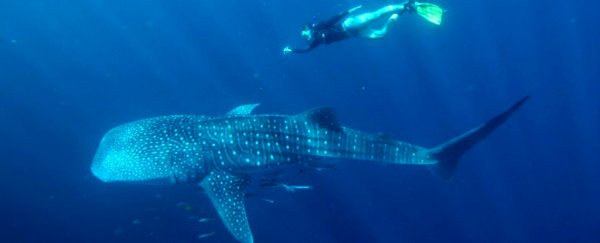Scientists have uncovered one of the secrets of the whale shark, the world's largest fish. The krill-feeding sharks are negatively buoyant, which means they sink to the bottom of the ocean to reach their food, conserving up to 30 percent of the energy needed to stay down.
This energy conservation allows the whale sharks to stay warmer for longer, which directly affects the length of time they can forage.
Mark Meekan, principal research scientist at the Australian Institute of Marine Science, says being negatively buoyant means they don't invest as much energy in swimming down. They tend to just glide their way.
"We estimate that this behaviour, followed by a steep return to the warmer surface waters, allows them to conserve up to 30 percent of the energy they would use up just swimming horizontally," he says.
"These ocean giants have another trick up their sleeve. Their critical organs are surrounded by huge blocks of white muscle that appear to insulate the whale shark, so that it stays warmer for longer, even during these long descents to much cooler depths."
For whale sharks, the larger they get, the more heat they can store and the longer they can forage in deep water, up to 500 m.
"Because of this, we think they have evolved to become bigger and bigger, so that today they grow up to 18 m long and can reach 34 tonnes in weight - larger even than many whales," says Meekan.
The scientists were able to record the swimming behaviour and location of whale sharks near Ningaloo Reef in Western Australia using data and video recorders and satellite tags.
They found that whale sharks spent almost 60 percent of their time at the surface where they bask in the warm waters.
The research is published in the journal of Frontiers of Marine Science.
Watch Australian scientists tag a whale shark of Ningaloo Reef in Western Australia:
This article was originally published by Business Insider.
More from Business Insider:
